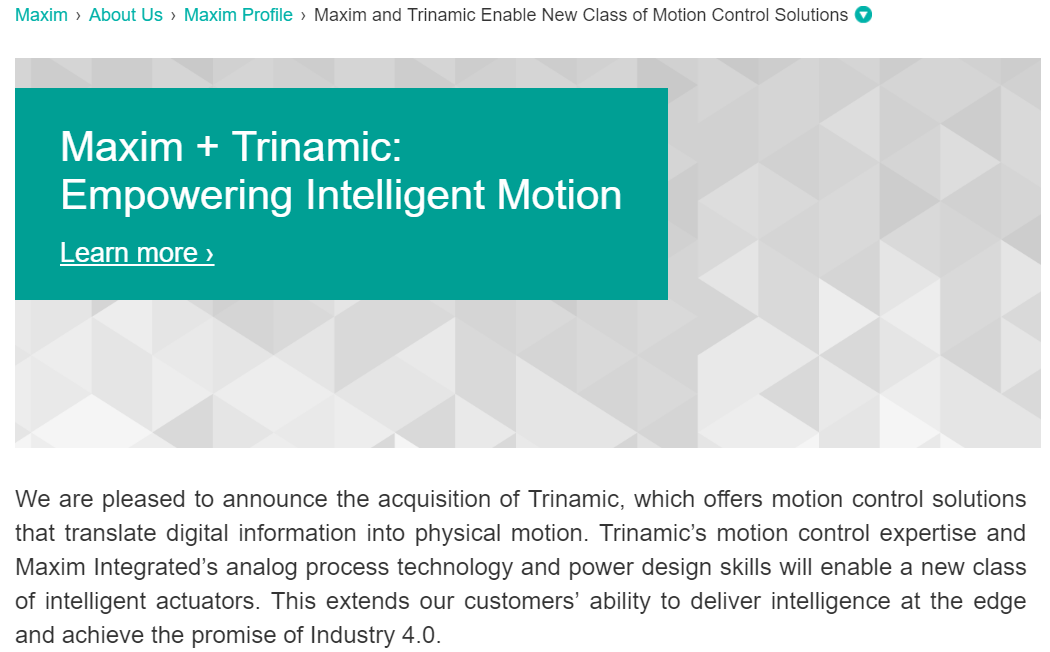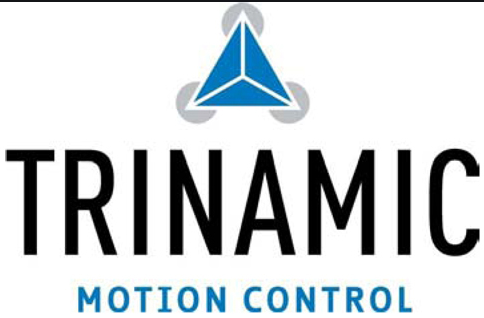July 09, 2021
3421
Recently, some insiders broke the news that on May 11, Maxim Integrated had completed the acquisition of Trinamic. According to the e-mail that broke the news, Trinamic’s focus will continue to ensure the continuity of the company’s products and services. Moreover, Maxim has no immediate plans to change its distribution and sales channels in the near future, and Trinamic will maintain the status quo and continue to operate for a period of time.
And then, we also saw the news of the acquisition on Maxim's official website. Maxim believes that after the combination with Trinamic, it will be more convenient to provide customers with industry 4.0 solutions with edge intelligence.

Who is Trinamic?
Trinamic may not be very familiar to most people, but engineers who do motor control should have heard of it. It is a motion control company headquartered in Hamburg, Germany, with subsidiaries in Tallinn, Estonia, Shanghai, China, and Chicago, Illinois, USA. They mainly provide chips, modules and all-in-one products related to motor control.

According to its official website, Trinamic develops the world's most advanced technology for motors and motion control. By using its integrated circuits, modules and mechatronics systems, software engineers can quickly and reliably develop high-precision drive controllers that work efficiently, smoothly and quietly.
The company started when founder and CEO Michael Randt and his colleagues Lars Larsson and Bernhard Dwersteg jointly developed motion control chips.
In 1996, they needed a reliable, stable and silent motor control solution, but there was no available hardware solution on the market, so they often used FPGA to do the same analog design over and over again.
Later, with the funding of the European Union, their three colleagues founded Trinamic Microcrystalline Company, rented an old workstation and CAE software, and used it mainly at night. By constantly experimenting with field programmable gate array (FPGA), digital and analog technologies, Trinamic Microcrystalline has created its first motion control chip.
"It's very huge!" Michael Randt explained with a smile: "We use 4-inch wafers, the size is 60 square millimeters." By 2004, together with Lars Larsson and Bernhard Dwersteg, he turned this prototype into a viable commercial motion control driver integrated circuit. Trinamic motion control company was born.
Now Trinamic has become a private company with more than 40 employees. Its products are mainly used in 3D printing, smart home, laboratory automation, medical and other applications.
They claim that they are not a semiconductor manufacturer that wants to sell more chips, they just want to design better drive products.
Why would motor chip manufacturers be acquired?
Trinamic, the company's development momentum in the past few years, is fairly good, with positive growth almost every year. Then why is it still acquired? In an email to agents and distributors, Michael Rand wrote, "Our business model, management structure, and corporate value are highly consistent."
Industry insiders also believe that there is complementarity between Maxim and Trinamic. Maxim has high-efficiency power analog devices and Trinamic has excellent motion control products. The combination of the two can provide a more complete Industry 4.0 solution.
In fact, Maxim also tried to make motor control products in the past long ago, but it has not been able to do so. This acquisition allows Maxim to realize its dream of motor product line.
Of course, Trinamic will also get a lot of benefits after the acquisition, such as the direct use of Maxim's advanced semiconductor manufacturing processes and sales channels. In this way, Trinamic can also do the research and development of technology and products more at ease, without worrying about the problem of unsatisfactory product sales.
After all, before a company's products are truly adopted by customers on a large scale, it is faced with the dilemma of continuous investment but low output profitability. This period is also the most difficult time for companies.
For example, another motor chip manufacturer, Active-Semi, was acquired by Qorvo at the end of last year. They developed motor chip products in 2012, but it didn't really start to generate business until 2015. But even if it is adopted by major customers, after being cut orders by major customers on a large scale last year, it is still unavoidable to be sold.
This may have something to do with the characteristics of motor chip products. The application market with large shipments is generally very competitive, such as power tools, sweepers, air ducts, fascia guns, fans and other applications. The price is not bad at the beginning. After the product was started, the price of the plan dropped all the way. Last year, the supplier of the motor-driven PCBA for power tools had a price of about 6 yuan, and the fascia gun drive solution also reached single digits in less than two or three months.
And what about a market where price competition is not so fierce? The shipment volume is correspondingly much smaller, and the shipment volume is not large. It may not have a great impact on the plan. Basically, there is still money to be made, but for chip manufacturers, it is different. After all, the volume The initial expenditure for producing a chip is fixed, and only when the shipment reaches a certain scale can the chip manufacturer make money. Therefore, chip manufacturers hope to find a market with large shipments. Before finding this market, either the company has other income to subsidize this part of the loss, or the investor can bear the previous loss.
Concluding
Some companies in the industry once complained to <Electronics enthusiasts.com> that it is not as good as making power chips to make money when making motor control chips, but they are responsible for the quality of the entire motor drive solution. No matter where there is a problem with the solution, the customer first Time will find them.
Therefore, some motor control chip companies began to integrate power devices into the control chip. Later, in order to ensure reliability and stability, and to increase some profits, some companies simply made control modules directly. Or an all-in-one machine, which not only includes power devices, but also includes control algorithms, and is sold together. Perhaps this is a development direction of motor chip products. Of course, even so, if you only make a single motor control product, you will still encounter bottlenecks if you want to continue to develop, just like Trinamic and Active-Semi, or merge into larger ones. In the group, it is either diversified.